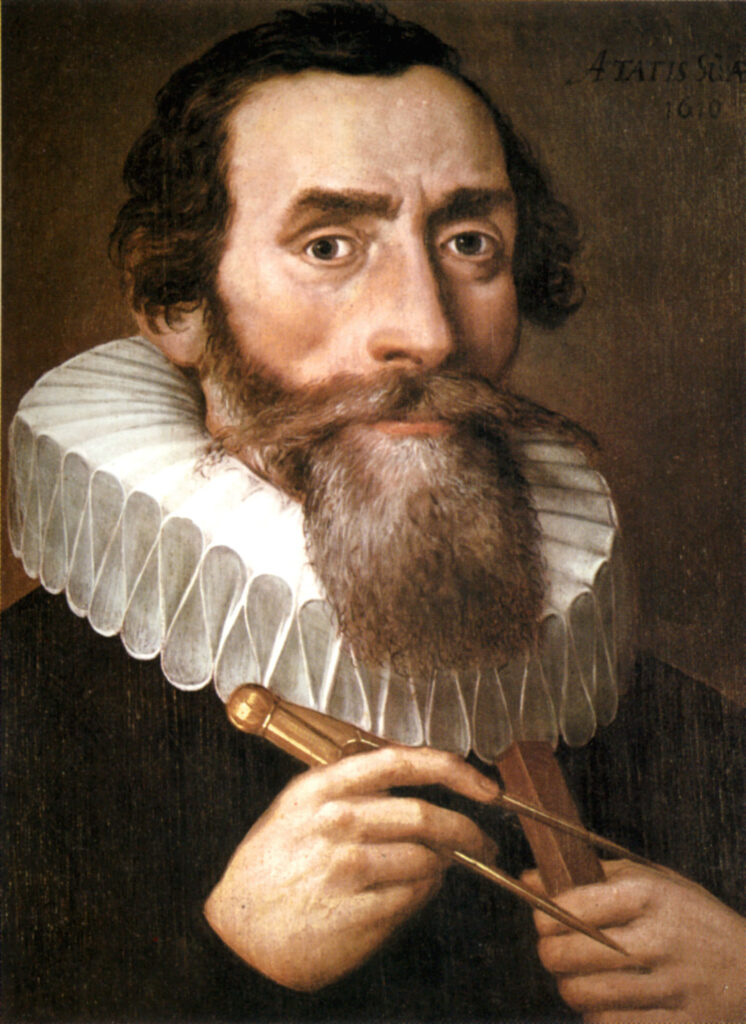Johannes Kepler was born on December 27, 1571, in Weil der Stadt, Wurttemberg, in what is now Germany. His father, a mercenary soldier, left the family when Kepler was five. Historians believe his father died soon afterwards. His mother was the daughter of an innkeeper and Johannes was put to work at the inn at a young age. Despite his poverty, he was able to attend Latin School at Maulbronn and at the age of twelve, enrolled in a Protestant Seminary in Adelberg. He earned a scholarship to the Lutheran University of Tübingen in 1589. By the time he received an M.A. in theology there in 1591 he had read of the Copernican model of the universe that stated the Sun, not the Earth, was the center of the Universe. Intrigued by this view, he decided to change his major studies to mathematics and astronomy. In 1594, he left the University to become a mathematics tutor in Graz, Austria where he continued his interest in astronomy. In 1596, he wrote the first influential defense of the Copernican system, the Mysterium Cosmographicum (The Sacred Mystery of the Cosmos).
In 1600, Kepler was forced out of his teaching post at Graz due to his Lutheran faith, and moved to Prague to work for the renowned Danish astronomer, Tycho Brahe. In 1601 Tycho died, and Kepler inherited his post as Imperial Mathematician to the Hapsburg Emperor. Using the precise data that Tycho had collected, Kepler discovered that the orbit of Mars was an ellipse, the first step towards his formulation of the laws of planetary motion. In 1606, he published De Stella Nova (Concerning the New Star) on a supernova (new star) that had appeared two years before. In 1609, Kepler published his book Astronomia Nova (New Astronomy) , which contained his first two laws of planetary motion. Due to his detailed calculations and data, some credit Kepler with the creation of what is now known as the scientific method.
In 1610, Kepler learned of Galileo’s use of the newly invented telescope in astronomy, which inspired him to build his own telescope. Later that year Kepler published a confirmation of Galileo’s observations of Jupiter’s moons, the Narratio de Observatis Quatuor Jovis Satellitibus (Narration about Four Satellites of Jupiter observed) , which lent further support to the Copernican model. In 1611, Kepler published Dioptrice, the first scientific discussion of the telescope.
Kepler lost his post in 1612 as Imperial Mathematician when Lutherans were expelled from Prague. He moved to Linz, Austria but had to return often to Wurttemberg where he successfully defended his mother against charges of witchcraft. In 1619, he published Harmonices Mundi (Harmony of the Worlds) , which contained his third law of planetary motion. In spite of more personal tragedies and the religious strife of the Thirty Years War, (1618-1648) Kepler continued his research, publishing the seven-volume Epitome Astronomiae Copernicanae (Epitome of Copernican Astronomy) in 1621. This important work played a major role in the eventual acceptance of Copernicus’ theories.
In 1627, Kepler completed the Rudolphine Tables, begun by Tycho Brae the previous century. These included calculations using logarithms, which Kepler developed, and provided perpetual tables for calculating planetary positions for any past or future date, forming the most concrete proof yet for the Copernican model of the Universe. Kepler also used the tables to predict a pair of transits by Mercury and Venus of the Sun, although he did not live long enough to witness the events.
Johannes Kepler died in Regensburg, Germany on November 15, 1630. His grave there was destroyed in 1632 by the Swedish army during the Thirty Years War. In poor health most of his life, and caught up in the religious turmoil of the Reformation, Kepler’s accomplishments as an astronomer, physicist, and mathematician seem even more remarkable. His greatest feat in astronomy was his explanation of planetary motion, which has earned him the title “founder of celestial mechanics” as he was the first person to identify “natural laws” in the modern sense. He was the first to prove that the ocean’s tides are due to the Moon’s gravity and pioneered the use of stellar parallax caused by the Earth’s orbit to measure the distance to the stars. Kepler was also the first to suggest that the Sun rotates about its axis, and coined the word “satellite.”
Kepler’s book Astronomia Pars Optica (the Optical Part of Astronomy) has earned him the title “founder of modern optics,” while his work Stereometria Doliorum Vianiaorum (The Stereometry of Wine Barrels) forms the basis of integral calculus. A devout Lutheran, he derived the birth year of Christ that is now universally accepted, and was the first to derive logarithms purely based on mathematics. Johannes Kepler’s most influential accomplishments in astronomy were his three Laws of Planetary Motion, which were used by Isaac Newton to develop his theory of universal gravitation:
-Kepler’s First Law: The planets move in elliptical orbits with the sun at a focus.
-Kepler’s Second Law: In their orbits around the sun, the planets sweep out equal areas in equal times.
-Kepler’s Third Law: The squares of the times to complete one orbit are proportional to the cubes of the average distances from the sun.
Kepler Crater on the Moon, Kepler Crater on Mars, asteroid 1134 Kepler, and Supernova 1604 are all named in his honor, as is the Kepler Space Observatory, NASA’s first planetary detection mission, which is due to be launched in October 2008. The Johannes Kepler University of Linz is also named for him.

